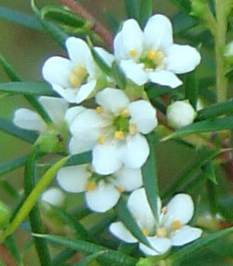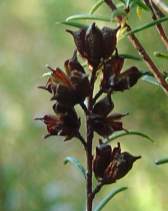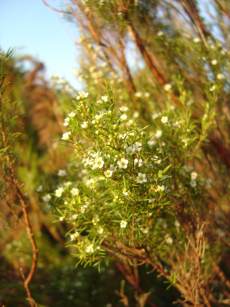Coleonema calycinum
Coleonema calycinum (Steud.) I.Williams
Family: Rutaceae
Common names: confetti bush, broom buchu (Eng.); boegoe (Afr.)
Introduction

Description
Description
Coleonema calycinum is an evergreen shrub and forms a single stem at ground level. The branches are erect, numerous, glabrous (hairless) and alternately arranged on the stems. The bark is reddish brown and transversely (crosswise) marked with leaf scars.
Masses of white flowers are borne singly, terminally or in the axils of the branches from June to September and attract bees and butterflies. The closed buds are some times pinkish. Flowers are 5-petalled, open and small, 5.5 x 6.5 mm. The petals are obtuse (rounded or blunt) and the staminodes are fused to the base of the petals. Flowers have a rum-like scent.

The leaves are glabrous, linear (13-19 mm long), narrow (0.7-1 mm wide) and alternately arranged on the branches. The glabrous fruit, 4.5 mm long, is dotted with oil glands. The fruit capsule consists of five chambers, each bearing one shiny black seed, 3.0-3.5 x 1.4-1.6 mm.The seed ripens in November to December. Empty seed capsules of the previous season can still be found on the shrub.

Conservation Status
Status
Coleonema calycinum is not protected by any South African legislation.
Distribution and habitat
Distribution description
Coeleonema calycinum grows at the base of rocky cliffs on mostly south-facing slopes. It occurs naturally on the sandstone and limestone mountain slopes from Worcester, Caledon to Bredasdorp, at an altitude of 5-1200 m.
Derivation of name and historical aspects
History
The genus name Coleonema is derived from the Greek words, koleos, meaning a sheath, and nema, meaning a thread/filament. Coleonema is recognized by the presence of five staminodes, which develop opposite each petal, hidden in the channel running down the face. Most of the scented species in this family are commonly known as buchu.
The genus consists of eight species which occur in the Western and Eastern Cape. Coleonema album, the white confetti bush, is a well-known garden plant. It forms a compact, round shrub and grows to a height of 2 m. Masses of small white flowers are borne at the branch tips during winter and spring. It is an ideal coastal plant, able to withstand strong sea winds. Coleonema pulchellum, the pink confetti bush grows to a height of 1 m and is covered in sweet-scented flowers from winter to spring. Coleonema pulchrum, the willow shrub, reaches a height of 1.5 m, the foliage is turpentine-scented and pink flowers cover the bush during winter and spring.
Ecology
Ecology
Insects are responsible for pollination, which are attracted to the plants in swarms. The seeds have an important role in the regeneration of this plant, as there is no indication of a persistent rootstock.
As the fruit ripens, the seed chambers split completely, through the drying and contracting of the inner side, which forcibly ejects the seeds. This is known as ballistic dispersal. The black seeds are dispersed away from the mother plant and collected by ants.
Uses
Use
Coleonema calycimun is an ideal hedge plant as it grows to a height over 2 m. The branches of this shrub were used to make brooms.

Growing Coleonema calycinum
Grow
Coleonema calycinum can be used as an accent plant, in groups to form a hedge, as a pot plant on the stoep / patio, or planted with fynbos species such as restios, ericas, pelargoniums, proteas, aloes and herbaceous perennials such as Phylica, Felicia and Geraniums and Pelargoniums to create an interesting fynbos garden.
This species requires full sun and will tolerate some semi-shade. It requires well-drained soil, compost and a well-balanced fertilizer (3:2:1). Plant out in groups of three or five with enough space to grow. Planting is best done during autumn, winter and spring. To retain soil moisture and keep weeds to a minimum, add a layer of mulch. They require good watering in winter and moderate watering in summer. Do not allow plants to dry out, and once established, they will survive periods of drought.
Coleonema calycinum can be propagated by sowing seed and by taking cuttings.
Fresh seed is collected from the previous year's flowers and stored upon ripening. The optimum time for sowing is during autumn. Clean seeds and sow on a prepared medium of sand and compost in equal parts in a seed tray. Cover seeds with a thin layer of bark and water. Place seed trays in a covered area with good light and ventilation. Keep seed trays damp and germination will take place within one to two months. Seedlings are pricked out when four true leaves have developed. The growing tips of seedlings are pinched out to encourage bushy growth. Feed buchus regularly with a balanced nutrient. The yellowing of leaves can be treated with an application of iron chelate.
Cuttings have the advantage of producing a larger flowering plant quicker than seedlings. Tip cuttings, 50-70 mm, are taken from the current year's growth. Prepare cuttings by making a clean cut below the node and remove a third of the foliage. The best time to process cuttings is during winter and spring. Dip the base of the cuttings in a rooting hormone. Firmly place the cuttings in a medium of 50 % bark and 50 % polystyrene. Ideally these cuttings should now be placed in an well-aerated propagation unit with a bottom heat of 24° C. Ideally, rooting occurs in 9-11 weeks. Carefully pot the rooted cuttings, using a well-drained, humus-rich, fynbos potting medium (2 parts leaf mould, 1 part coarse sand). Plants will be ready for planting in 7-8 months. Feed regularly with a well-balanced nutrient.
Phytophtera cinnamonnii, a soil-borne fungus, attacks the roots of most fynbos species. It prevents the uptake of water causing plants to die. The fungus is most active when the soil temperature is high, especially during summer. Remove infected plants and use soil mulch to reduce the soil temperature. Treat plants with a special fungicide prior to planting out. This is a precautionary measure to control the fungus and to protect adjacent plants.
References
- Gold, M. 1992. The buchus: cultivation and propagation. National Botanical Institute, Kirstenbosch.
- Goldblatt, P. & Mannning, J. 2000. Cape plants. A conspectus of the Cape Flora of South Africa. Strelitzia 9. National Botanical Institute, Pretoria & Missouri Botanical Garden, Missouri.
- Powrie, F. 1998. Grow South African plants. National Botanical Institute, Cape Town.
- Trinder-Smith, T., H. 2003. The Levyns guide to the plant genera of the southwestern Cape. Red Roof Design, Cape Town.
Credits
Author
Norma Jodamus
Kirstenbosch NBG
July 2007
Plant Attributes:
Plant Type: Shrub
SA Distribution: Western Cape
Soil type: Sandy
Flowering season: Spring, Winter
PH: Acid, Alkaline, Neutral
Flower colour: White
Aspect: Full Sun
Gardening skill: Average
Special Features:
Horticultural zones








Rate this article
Article well written and informative
Rate this plant
Is this an interesting plant?
Login to add your Comment
Back to topNot registered yet? Click here to register.